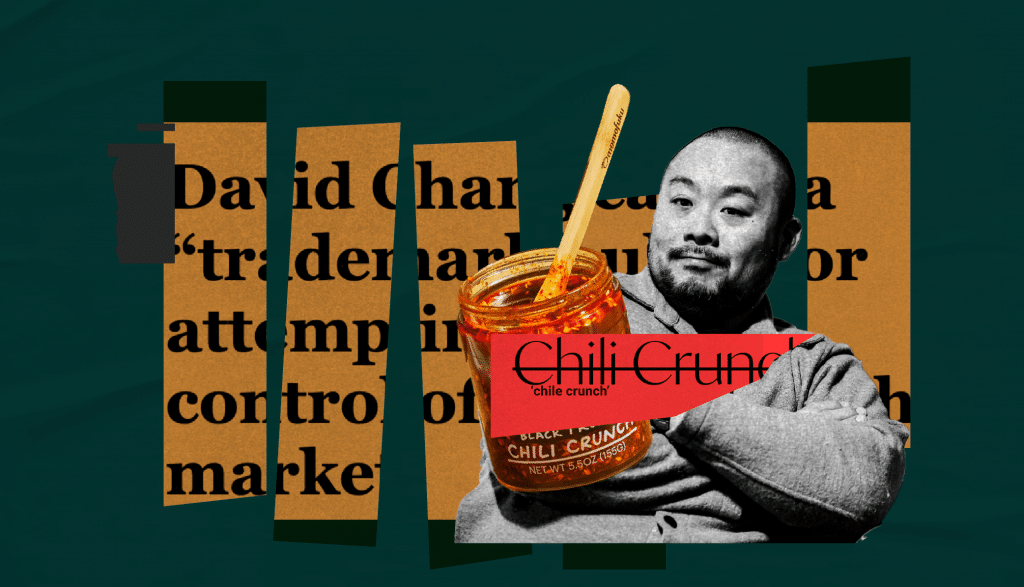Last month, David Chang, Korean-American restaurateur and Founder of Momofuku Restaurant Group, was called a “trademark bully” for going after companies using “chili crunch” and “chile crunch” on their condiment labels.
As per Salon.com:
“Chili crisp, a fiery red condiment rooted in Chinese cuisine, is a pantry staple for households nationwide thanks to several businesses — big and small alike — that have released their own brands. Made with fried chili pepper and aromatics infused in oil, the condiment can be found at restaurants and local supermarkets (i.e. Trader Joe’s). There’s even a cookbook solely dedicated to chili crisp.
The terms “chili crunch” and “chile crunch,” renditions of chili crisp, have found themselves at the center of controversy after David Chang’s food empire Momofuku Goods sought to trademark the label”
Momofuku Restaurant Group was sending cease-and-desist letters to several companies – some of which were mom-and-pop shops – for the usage of “chili crunch” which is “like trying to claim ‘ketchup’ or ‘mayo’” stated actor Simu Liu on X.
Whilst the story in and of itself is highly intriguing, it illustrates several bigger underlying issues with Asian communities and – more specifically – the overall approach of David Chang and others who do the same.
Firstly, the word “Momofuku” has a Japanese-Taiwanese origin. Chili crunch has Chinese origins. And lastly, David Chang is Korean-American. The homogenization of Asian subcultures into neat mainstream packaging without any nuance is harmful and reeks of white approval. In order to uplift Asian communities, we must educate on the different cultures and subcultures, rather than watering-down the story for palatability. It may be more difficult to and it may cause resistance, but it’s the right thing to do to help advance Asian communities as a whole. Unsurprisingly, there’s a detailed history related to both Asian communities and taking the more palatable approach in search of white approval, which is what David’s team is doing. Asian-Americans and Asian-Canadians were the primary examples of the “model minority”, which referred to a stereotype that certain minority groups, particularly Asians, had adjusted well to North American life and had little or no need for social or economic assistance compared to other minority groups. With this knowledge, it’s hard not to make the connection between history and David’s approach to his business. Afterall, we are all informed and raised by our ancestors.
Secondly, Asians as a whole are an underrepresented community. As such, celebrities like David Chang who have privilege, should be using that privilege to uplift others in the community, rather than push them down for more personal and/or financial gain. The attempted monopolization of Asian cuisine on Momofuku’s part is a clear-cut attempt to remove the nuance in the market and uplift themselves as the token (albeit a very successful token). But why does this matter? Isn’t it just business? Well, what may seem like a cut-throat yet savvy business decision has actually already failed with Asian audiences – their primary customer base, who have already called him out for his actions. Unfortunately for David and Momofuku, more and more people understand that the end goal is not to put the Asian community in a position again to be a token within North America (as they have been for many decades). The end goal is to uplift the entire community and know that “all boats rise with the tide”.
So as marketers and communicators, what are the two main lessons we can learn from David and Momofuku’s missteps?
- Deep, culturally nuanced storytelling is the most effective and inclusive way to tell stories. If you homogenize in search of palatability and white approval, you are actually turning on the underrepresented voices your stories are claiming to support.
- Your audiences are more globalized and interculturally competent than ever before. This means that they see the bigger picture; they understand our interconnectedness; and they will financially and vocally support authentically inclusive work that truly uplifts communities – rather than performative and tokenized actions.
Update: Since this story was written, David Chang and Momofuku Restaurant Group have issued an apology and stated they would not enforce the trademark. With that said, the lessons learned from this incident still stand.









